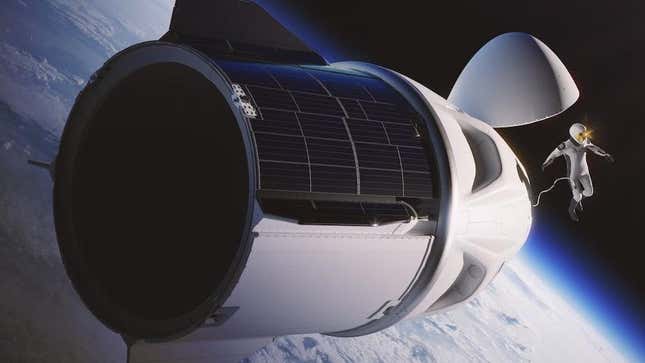
Jared Isaacman, mission commander for the first all-private trek to Earth orbit, can’t get enough of space. The billionaire space tourist has purchased three new flights with SpaceX, including one that could launch later this year.
The stated purpose of the three missions is to “rapidly advance human spaceflight capabilities” and raise funds for important causes, according to a Polaris statement announcing the new program on February 14. That, and Isaacman, the founder and CEO of Shift4, is itching to get back into space.
Indeed, with his deep pockets and net worth of around $1.4 billion, Isaacman is capable of making this happen, and this latest move is—undoubtedly—a conspicuous display of wealth. At the same time, however, these three missions are not pure indulgences; Polaris will raise money for charities, conduct scientific research, and demonstrate new technologies.
The first of the three missions, known as Polaris Dawn, is expected to launch no earlier than the fourth quarter of 2022. The program will reach a climax with the first flight of an all-private crew on a SpaceX Starship megarocket. Speaking to reporters on Monday, Isaacman said the “program has been purposefully designed to advance long-duration human spaceflight capabilities and [to guide] us toward the ultimate goal of facilitating Mars exploration,” as Spacenews reported.
Isaacman was the mission commander for the Inspiration4 mission, the first all-private trip to Earth orbit. The crew rode inside a SpaceX Crew Dragon from September 16 to 18, 2021, raising $240 million for St. Jude Children’s Research Hospital in the process. The historic mission went off without a hitch, oh, except for that busted toilet.
The cost of Inspiration4 was not disclosed, but SpaceX CEO Elon Musk reportedly plans to charge $50 million per seat for similar trips in the future. During Monday’s press conference, Isaacman said he was “not going to comment” on how much he paid for the three Polaris flights, aside from saying the missions are “fully funded” and that he received some financial support from SpaceX.
Polaris Dawn has set some ambitious goals. The mission will attempt to achieve the highest Earth orbit ever flown (the current record belongs to Gemini 11, which reached a maximum height of approximately 854 miles (1,375 km) in 1966), test laser-based communications using SpaceX’s Starlink network, and, perhaps most daringly, perform the world’s first commercial spacewalk.
Polaris Dawn will launch on a SpaceX Falcon 9 rocket from Kennedy Space Center in Florida and spend five days in Earth orbit. Its crew will consist of mission commander Isaacman, mission commander Scott Poteet, mission specialist Sarah Gillis, and mission specialist and medical officer Anna Menon. The expert crew will demo new tech and perform scientific work meant to advance long-duration spaceflights, such as tests to study decompression sickness and exposure to radiation. Contributing institutions will include Weill Cornell Medicine, Johns Hopkins University, Translational Research Institute for Space Health (TRISH), the University of Colorado Boulder, and the U.S. Air Force Academy, among others.
Because Dragon does not come equipped with an airlock, all four crewmembers will be required to either perform a spacewalk or stay inside a fully depressurized capsule. To not get killed in the process, the crew will wear extravehicular activity (EVA) spacesuits designed by SpaceX. These suits—not yet developed—will be upgraded from the current intravehicle suits used by Dragon crewmembers. The “development of this suit and the execution of the EVA will be important steps toward a scalable design for spacesuits on future long-duration missions,” according to Polaris. Speaking of long missions, that laser communications system I talked about is being tested for human flights to the Moon and Mars.
The timelines for the second and third missions were not disclosed, which makes total sense for the third mission—Starship has never flown to space. In related news from yesterday, The FAA announced a delay in its environmental review, moving it from February 28 to March 28, as the agency explained in an emailed statement; the fully stacked Starship can’t fly from SpaceX’s base in Boca Chica, Texas, until the FAA says it’s okay to do so. It’s also worth noting that the first private flight on Starship won’t happen until the rocket is proven safe and reliable, which will undoubtedly require multiple tests.
It certainly feels like we’re at the dawn of a new era. The Polaris Program combines space tourism with serious business, along with a dash of charity thrown in to improve the optics. It should come to no surprise that rich people are the first to use space as their personal playgrounds and workspaces. The rest of us have to be content to watch, and only hope that someday, somehow, we can partake as well. That day, at least the way I see it, is still not bound to happen for a considerable time to come.
More: Plot Twist: A Different Rogue Rocket Is Going to Hit the Moon.